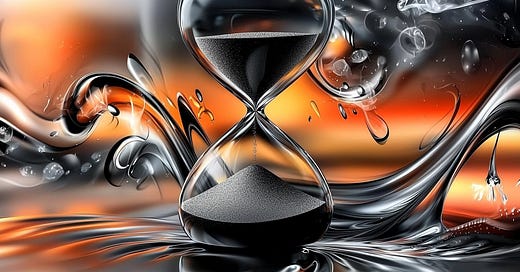What 90 Minutes in "Flow" Can Do (That 9 Hours Can't)
The surprising truth about energy cycles, deep work, and creative breakthroughs
Flow is a learn-able state where skill meets just-right challenge, time dissolves, and productivity feels effortless.
Grounded in Mihály Csíkszentmihályi’s foundational work, recent neuro-imaging shows that when experienced creators “let go,” executive control networks quiet while sensory-motor circuits surge, unleashing a dopamine-driven combination of laser focus and joy.
Researchers and performance coaches now map dozens of reliable “triggers” that creators can stack - goal clarity, novelty, risk, deep focus - to shorten the on-ramp and stay in the zone longer.
This field guide distills that science into step-by-step practices you can deploy before, during, and after a session, whether you paint, code, film, or write.
🧠 | What Flow Is—and Why Creators Crave It
Psychologist Csíkszentmihályi defined flow as total absorption in a task that is both meaningful and optimally challenging. People in flow report higher creativity, faster learning, and deeper life satisfaction. EEG and fMRI work from Drexel University confirms a pattern called transient hypofrontality: frontal self-monitoring quiets, freeing practiced neural circuits to improvise with stunning efficiency.
🎛️ | Stage Setting: Prime Your Environment and Mind
Craft a one-minute launch ritual
Athletes and musicians use micro-rituals—breath patterns, mantra, stretching—to signal “game on” to the nervous system. Pick a simple sequence (e.g., brew tea → box-breath → open project file) and repeat it before every session until the actions themselves become a neural switch.
Design a low-friction workspace
Noise is flow’s kryptonite. Jabra’s 2024 survey links chronic office noise to drops in focus and spikes in stress; acoustic tweaks and good headphones cut distraction in half. If you work in an open plan, strategic use of privacy pods or noise-canceling cans can reclaim mental bandwidth.
Sync with your ultradian rhythm
Brain-energy studies show performance peaks follow a roughly 90-minute work / 15-20-minute rest cycle—the same oscillation that structures REM sleep. Time-blocking around this natural pulse prevents the slow bleed of mental fatigue.
🚀 | Launch Procedures: Reliable On-Ramps into Flow
Find the 4 % sweet spot – Set goals just beyond current ability; Kotler’s research pegs the ideal gap at about four percent harder than comfortable, enough to stretch but not snap.
Leverage curiosity and novelty – Fresh problems spike dopamine, sharpening attention. Rewrite dull briefs into intriguing puzzles (“How would Miyazaki storyboard this insurance explainer?”).
Add measured risk – Posting a live demo or promising a draft to peers raises adrenaline gently, increasing focus without tipping into panic.
Guarantee immediate feedback – Visible brush strokes, real-time code tests, or a word-count tracker close the action-feedback loop the brain relies on during flow.
🌊 | Staying in the Current
Single-task with ruthless intent
Multitasking shreds flow. Silence notifications, close extra tabs, and commit to one clear objective for the next cycle. Workers who protect focus report fewer errors and reach deliverables faster.
Use strategic micro-breaks
Short movement bursts (30 seconds to 5 minutes) restore glucose and reset attention without scattering context. A 2025 Apollo Technical review found micro-breaks cut afternoon fatigue by 60 %. Pair them with the larger 15-minute rests in your 90-minute rhythm.
Keep tuning the challenge dial
If boredom creeps in, raise complexity (new constraint, tighter rhyme scheme). If anxiety spikes, slice the task thinner or rehearse a skill in isolation. Continuous calibration keeps you in the “flow channel.”
🎷 | Flow Together: Turning Teams into Jazz Quartets
Group flow emerges when members share a compelling goal, trust one another, and exchange rapid, unfiltered feedback—much like a jazz combo improvising. Daily stand-ups for intent-sync, latency-free whiteboards, and a norm of psychological safety transform collaboration days from chaos into co-created brilliance.
🛠️ | Rapid Troubleshooting
Blank-page dread? Five-minute free-write to reignite curiosity.
Mid-project stall? Raise stakes—schedule a public share 48 hours out.
Noise chaos? Switch to brown-noise playlist plus headphones.
Overwhelm? Box-breath, then define the next actionable inch.
Flow dropout? Quick self-check—read aloud, sketch a different angle, or run unit tests to regenerate feedback.
Each technique realigns one of the four core ingredients: clear goal, sweet-spot challenge, immediate feedback, or deep focus—your master levers for re-entering the current.
🌅 | Closing Ripple
Flow is not mystical luck; it is infrastructure. By scripting rituals, building distraction-proof spaces, aligning tasks with curiosity and skill edge, and honoring the brain’s work-rest cadence, you nudge neurobiology toward its most efficient mode on command.
Treat the tactics above as modular experiments: stack two or three, note what resonates, iterate. With practice, downstream creativity feels less like grinding upstream and more like shooting white-water rapids on a crystal-clear creative river.
Instant access. No commitment. Cancel anytime.
References
PositivePsychology.com – “Mihály Csíkszentmihályi: The Father of Flow” (positivepsychology.com)
Drexel University News – “Your Brain in the Zone: A New Neuroimaging Study Reveals How the Brain Achieves a Creative Flow State” (drexel.edu)
Flow Research Collective – “What Are Flow Triggers? 22 Examples to Unlock Flow State” (flowresearchcollective.com)
Flow Research Collective – “Flow Trigger: The Challenge/Skill Ratio”
Ahead-App Blog – “The Science of Time Blocks: Why 90-Minute Focus Sessions Transform Productivity” (ahead-app.com)
Jabra Thought Leadership – “Making the Workplace Sound Better” (jabra.com)
Business.com – “How Open Office Plans Affect Workplace Productivity” (business.com)
Haworth – “Decrease Office Noise to Increase Productivity” (haworth.com)
Apollo Technical – “How Micro Breaks at Work Can Boost Productivity” (apollotechnical.com)
TIME Magazine – “How ‘Micro-Breaks’ Can Help You Feel Better at Work” (time.com)
Psychology Today – “The Psychology and Neuroscience of Curiosity” (psychologytoday.com)
Medium – “The Neuroscience of Flow State: Fine-Tuning Your Brain to Achieve Effortless Productivity” (medium.com)
Headspace – “What Is a Flow State and What Are Its Benefits?” (headspace.com)
TIME Magazine – “Are You Just Tired or Truly Burned Out?” (time.com)
Cell Press Trends in Neurosciences – “Curiosity-Driven Exploration: Foundations in Neuroscience” (sciencedirect.com)








